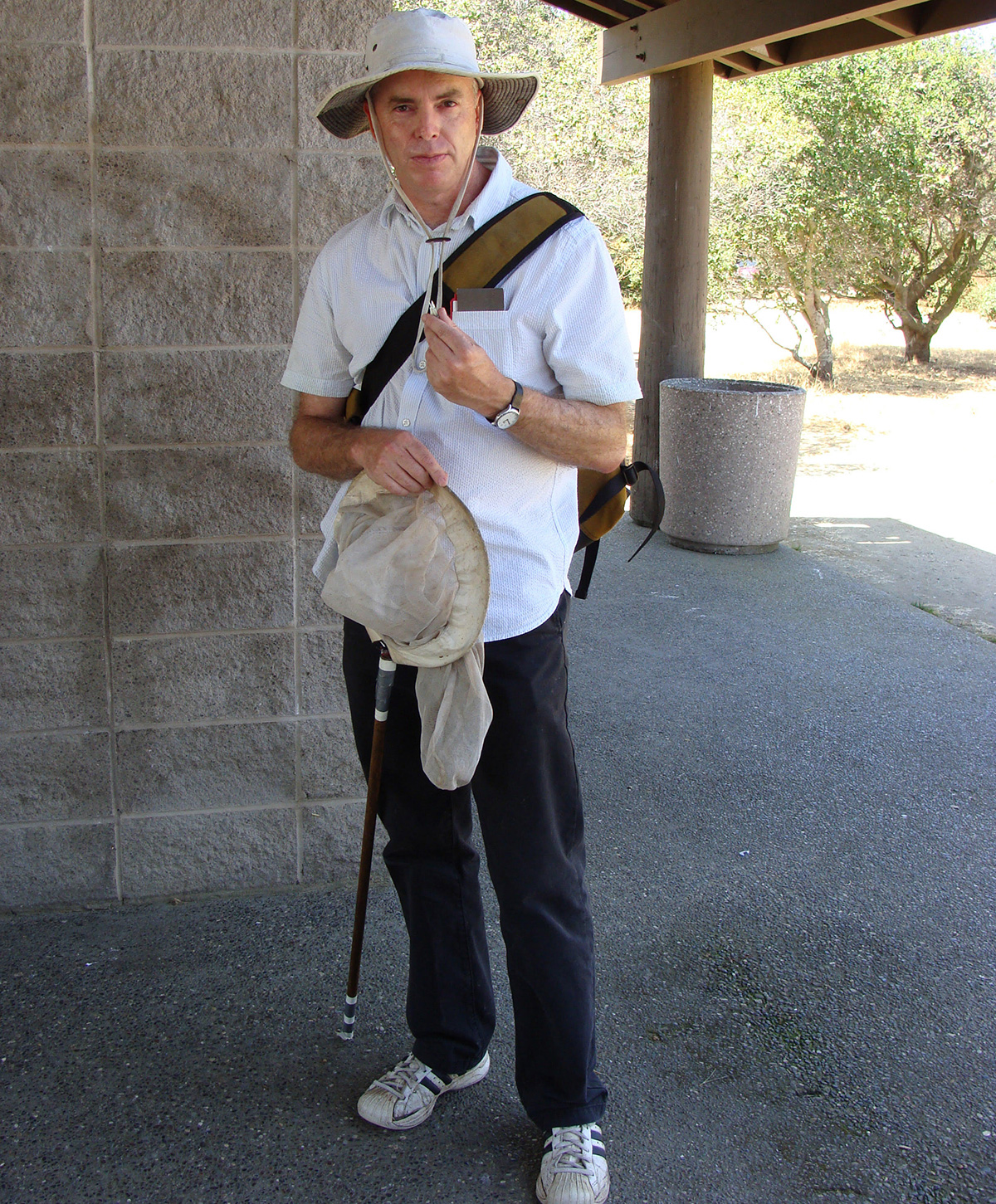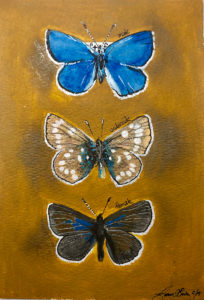
One of the best photos I’ve ever taken was that of my two nieces, Caitlin and Meghan, in an alkali marsh in Benicia. They are both carrying butterfly nets and toy binoculars — perfectly geared up to spend the day with their eccentric Uncle Liam looking for butterflies. The camera caught an extraordinary moment of innocence that, even to this day, transcends the scrapbook.
Caitlin on the left, transfixed by something in the foreground, and Meghan, the younger of the two, staring straight out in a forlorn manner beyond the horizon of the Carquinez Strait. It’s Meghan’s gaze that has me inspired this morning. Many things converge there: elementary school, children in nature, curiosity, but above all, this: when did we stop letting children run free with a butterfly net? Or collecting butterflies?
“The era of hobby collecting is effectively over,” UC Davis lepidopterist Art Shapiro writes in his Field Guide to Butterflies of the San Francisco Bay and Sacramento Valley Regions. “The psychic income from traditional collecting can be gotten from butterfly watching — the joy of physical possession is redirected from the animal itself, dead on a pin, to one’s notebooks or photos or video or recording of the animal in life. I think this is for the good.”
I disagree. Now is not the time to halt this adolescent, Norman Rockwell rite-of-passage. I’m struck by how rare it is to see this scenario anymore — the youthful, cheetah-like focus of a child madly running down a cabbage white and feeling so amazing that they caught it … and 98% of the time letting it go.
I wasn’t expecting Caitlin and Meghan to become collectors that day, but where do those kids go (the other 2%) if they do have that impulse? How will adults, parents and teachers treat that budding lepidopterist? I’m worried about the next E.O. Wilson or Jane Goodall, who is, let’s say, eight years old right now, and wants to start a butterfly collection and must reveal this in hushed tones to a world of adults that have decided the hobby is … passe.
In this new era of citizen science, a child with a net can, with one swipe, discover a new order of insects that had been hiding in plain sight. The tool is at the end of their arm and at the front of their curiosity.
Most people that go on to higher entomological studies begin with an insect collection. Hard to imagine this occurring only with a pair of binoculars. I insist the tactile collection is paramount to instilling and cementing the desire in the child that does want to do it. Mixed with an understanding adult, these specially-curious adolescents are only going to make this journey if someone early on put a butterfly net in their hands.
Robert Michael Pyle thinks so. Founder of the Xerces Society and considered by many to be the Godfather of American Butterflying, Pyle has partnered with the Lepidopterists’ Society and created the “Outer Net Project” (get it?) for kids, kindergarten through high school, to explore the world by giving them a net.
There is so much more to explore, and research by amateurs expands the overall knowledge of professional lepidopterists. In this new era of citizen science, a child with a net can, with one swipe, discover a new order of insects that had been hiding in plain sight. The tool is at the end of their arm and at the front of their curiosity.
It’s actually an extraordinary time to be out there looking, with the plummeting numbers recently reported globally on insects. Insects and butterfly populations always fluctuate but the staggering rate that things are disappearing now seems to be wiping the slate clean. So much real good can come of a curious child that discovers pieces of a rebounding species or a new range. It might not be for years until a wiser entomologist gets hold of that childhood collection, but everything could turn on what is pinned into a single box.
In the Peter Laufer book The Dangerous World of Butterflies, Chris Nagano, a Yale-trained field biologist for U.S. Fish & Wildlife (and someone I’ve worked with to conserve the federally endangered Mission Blue butterfly) is quoted saying, “I think there is a real value in collecting and enjoying it. Butterflies are easy to collect. They’re beautiful. My Mom would drop me off in the Santa Monica Mountains and come back a couple of hours later. I’d just go out and collect.”
He thinks kids collecting is fine — although, he says, “obviously not endangered species or in National Parks.”
One of things that complicates this issue is that people wrongly apply vertebrate mortality to invertebrate mortality. Female bugs lay many, many more eggs than their mammal counterparts. Parents may think, “I don’t want my child killing things.” But even with a net, studies have found that a single human has a hard time making any dent on any given population of insects on any given day. I hate to break it to you but that family car kills more butterflies each day that your passionate child ever could.

Years back, I swung my net at a white butterfly, the white color just odd enough to make me think it was something other than a cabbage white. Lo and behold, I examined my catch to find a Checkered White (Pontia protodyce) — a rare butterfly in San Francisco and one I did not recall seeing on the county list. (Lepidopterists refer to “lists” of what species are found in what county; you can find iNaturalist’s San Francisco butterfly list here.)
The swing caught the eye of a summer camp group, which I hadn’t noticed before. Within seconds, I had 15 little faces surrounding me at waist level, eyes bugged out of their little sockets like Christmas morning. A bazillion questions catapulted at once: “Is that a butterfly net?” “What did you catch?” “What are you doing, Mister?” and a symphony of overlapping “Can I see?” “Can I see?” “Can I see?”
I just kept thinking this is how you get pink eye.
I retrieved the butterfly from the net, loosely holding it at its thorax between thumb and index finger. Little hands pulling by now on the net. I knew this was an important specimen and it really needed to go in a drawer at the California Academy of Sciences. And then, out of nowhere, during a lull in hysterical frenzy, came the question: “You’re not gonna kill it, are ya, Mister?”
The tiny, doe-eyed boy was from Central Innocence Casting and delivered the line probably not too different from the famous baseball “Say It Ain’t So, Joe.” I held the butterfly. Fifteen little faces looking up at me. I weighed my few options.
A grad student meets his research advisor for the first time in an excerpt from Pyle’s novel Magdalena Mountain:
“I collected butterflies and moths when I was younger,” Mead said, “Just locally.”
“Why did you stop?”
“Same as most kids, I guess — girls and sports — embarrassed by the net, I suppose.”
“We lose a lot that way,” Lancaster sighed. “It becomes socially penalizing.”
Many a morning I’ve been crammed into the Muni underground train on my way to survey Mission Blues. All of us smashed in, holding handles above and coffee-to-go in the other. “Is that a … butterfly net?”
It’s always asked in the same way: the first three words delivered always on the same note. Once they hit “butterfly,” it goes up an octave, and “net” is asked in incredulous disbelief. “Yep,” I return, trying not to hit anyone’s face from the object protruding from my backpack. “All of us off to work, I guess.”
Almost all turn away with a smile. One can see the cherished memories in their eyes. Something about a net. As magical and mysterious as a divining rod. David Windham referred to it as turning “towards the happy, hopeful past when one was capable of everything because one had not yet tried anything.”
So, for the sake of the Darwin your child may become, or the adult that needs an escape, please go buy your kid a butterfly net.
For the record, I let the checkered white go that day. I’m … not sure why.


